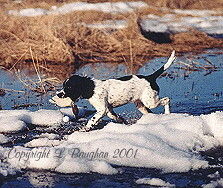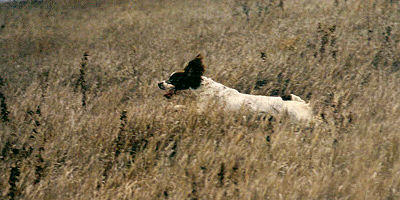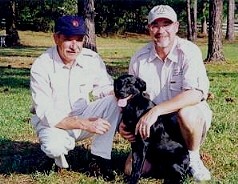  When training your dog, moving from distractions that are created using tennis balls and dummies to distractions created by live game is a big jump. In the field or wherever we are shooting, there is bound to be distractions occurring on a regular basis. You have sent your dog for a diving wounded duck. He has made a great job of getting it and is returning. Suddenly, another flight of duck come over his head and you take a shot bringing one down dead to splash in the water. Even though you had left the duck until it would fall away from him, he cannot resist the temptation. He drops the wounded duck and heads off for the dead one. It’s a scenario many of us have seen on more than one occasion - especially when picking up on a shoot.
Whether pheasant or duck, wounded birds are collected the moment they hit the ground. The faster your dog returns to you the quicker you can get him onto the second bird. Therefore, it is essential that you develop as fast and reliable a return as possible. He knows then that the moment you take the bird he will be turned around and sent for the second one. Control and basic foundations of training are essential at this stage. It is about this time when you realize whether you have reinforced and practiced them enough.
The relationship between you and your dog should be such that he not only knows but wants to bring the retrieve in his mouth back to you and share it. When another bird falls from the sky as he is returning, reinforce the return with the recall whistle if he is seen to hesitate at all. Do this especially in training so that he knows he is expected to come back with the one in his mouth. Some dogs learn to stop and watch the falling bird, some will continue returning and again watch the bird that has just been shot as it falls. This can be good as he may be expected to go for that one afterwards and it will help if he marks the fall. As long as he does not drop the retrieve in his mouth, there is no problem with this. If he does drop the retrieve, move closer, stop him going towards the second bird and insist he brings back the one he had in his mouth. In this way he will realize that he does not get the second until he returns with the first.
A moving bird or rabbit is always more interesting and motivating to your dog than a dead or captured one in his mouth. This is where the problem arises. His motivation to go chase and retrieve one falling from the sky is stronger than bringing the one he already has in his mouth back to you. Hence, the need to have good control. He has to know that he must bring the one he has already retrieved back to you before going for another.
"Control and basic foundations of training are essential at this stage. It is about this time when you realize whether you have reinforced and practiced them enough."
One of the best ways for training your dog to do this is by using a rabbit pen, if you have the availability of one. Moving rabbits are always far more interesting than going for a retrieve in the pen. Therefore, once you have steadied your dog in the pen and he is happy to hunt and watch them away - or walk around with the rabbits scuttling everywhere, begin to do short simple retrieves in the pen. With some dogs, I have found that the retrieve object I send them for has to be one that they really enjoy. A dead bird or a dummy covered with rabbit skin is a good choice. Where the dog is really only interested in cold game, I gradually wean them off this in the pen until I can have them retrieving anything that I throw… ignoring the running rabbits. Usually, I find that a tennis ball creates enough interest. Once you can do this with your dog, start giving him memory retrieves in the rabbit pen. Drop a dummy or tennis ball and then either hunt him or walk him away from it, flushing rabbits as you go. Then turn him around and send him for the dummy. Initially, do this at short distances and after a short hunt or walk - so that he does not forget the dummy.
Remember that watching and working the live rabbits will initially, easily and quickly clear his memory. In the video I made with Paul French, we clearly demonstrate this with both retrievers and spaniels. With the retrievers, I get the rabbits congregating in the center of the pen by putting a pile of food there. Then I bring the retriever in and give him retrieves where he has to run through the feeding rabbits. Rabbits scatter in all directions but his focus is on the retrieve. And that is what we are looking for.
It is more difficult, of course, to do this without the pen but if you have a friendly gamekeeper who trusts you and understands what you are attempting to achieve, he may allow you to do similar exercises in the pheasant pen. I was lucky. One of my gamekeeper friends made a habit of inviting me into and around the pens at feed times. We would first either hunt or walk the birds back to the pen and then feed the birds around the dogs. The dogs sat there and watched them as feed was sprinkled around their feet and sometimes even on their backs for the birds to peck off. I would then give them a retrieve of a dummy in the pen. Occasionally, if the keeper found a dead bird, he would put it on one side for me to use as a retrieve. We would bare a little of the flesh and use this for the dog to fetch among the healthy pheasants. Very quickly, the dogs learned what was to be retrieved and what was not to be touched.
On shoot days, this gave me the privileged position of being the one who picked up in the pheasant pen after a drive. The dogs scented and knew which were damaged birds and which were healthy, leaving the healthy ones alone.
Both of these options may be difficult for you. In this case, think about the motivations of your dog regarding the type of retrieve he enjoys. A canvas dummy is usually the lowest on the list of motivations. A tennis ball is more interesting, a rabbit skin dummy even more, a cold dead bird slightly better, a warm dead bird even better and the most exciting is a live bird or rabbit. If we use a dummy for the retrieve and then throw a tennis ball as a distraction, the tennis ball will usually be more tempting, if we throw cold game it will be even more of a distraction. If your dog associates the shot with a retrieve, firing a shot when you throw the second dummy will create a higher temptation. Therefore, gradually introduce and use distractions that create a greater desire in your dog to drop what he is carrying and go after that one. With each increase in temptation, be on your toes and encourage your dog to come back with what he is carrying and then, while he waits, go and pick the distraction yourself. Only when you are certain that he is coming cleanly back and not being strongly tempted should you send him for the distraction, and then not every time.
"Therefore, it is important to get it right - really right - on land first before you move onto water."
I started off with a duck shooting scene and this is where the biggest problems can arise, as once in water, it is difficult to get to your dog to insist he brings back the one in his mouth. And, he can quickly learn this limitation on your part. Therefore, it is important to get it right - really right - on land first before you move onto water.
One method that I have used to avoid and minimize swapping birds is to ensure that the dog never gets the distraction bird. On land, you may have an assistant who quickly picks the distraction, should the dog go for it. On water, attach a long piece of light cord to the distraction and quickly reel it in if the dog is at all tempted and heads towards it. If the distraction is close enough to the shore, the look of amazement as the distraction ‘bird’ flies out of the water - sometimes even over the dogs head - is something to behold.
It does help to occasionally go out with a fellow trainer and let his dog have the second retrieve. You can then do the same for him. By picking birds yourself, having an assistant and a fellow trainer’s dog pick them - as well as allowing your dog to have the occasional retrieve on the distraction bird - your dog will never be sure when it is his bird to pick. Only you will determine that and he will learn to bring back the best ‘prize’ he has at that moment… which is the one in his mouth.
|


